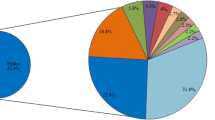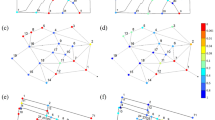Abstract
The supply of municipal water in Germany is often governed by policies that warrant occurrence-based reliabilities of 99.5 % or more. Such reliabilities have to be considered in the optimization of reservoir operation. A reliability-based optimization requires sufficiently long simulation periods of several thousand years of time series of inflow and demand. However, long simulation periods lead, especially for multi-objective parameterization–simulation–optimization (MOPSO), to unacceptable computational burden. Therefore, techniques need to be developed that increase the computational efficiency of MOPSO for such optimization problems. In this paper, a novel Monte Carlo recombination method (MCR) is proposed. MCR reduces the length of inflow time series significantly while preserving critical statistics, i.e., characteristics of probability distributions and variability of wet and dry conditions. It could be shown that simulations based on these shortened time series allow for highly efficient MOPSO and yield comparable Pareto-fronts and reliabilities. For the demonstration of the capabilities of MCR, it is integrated into a MOPSO framework for the optimization of a multi-purpose multi-reservoir system in the Eastern Ore Mountains, Germany. For this real-world application, synthetic time series of a length of 10,000 years are generated and reduced to 882 years, which results in a reduction of the computational burden by a factor of eleven. A validation of the results shows that the MOPSO framework allows for optimization of operational policies that yield reliabilities over 99.95 % on a monthly scale and up to 99.7 % on an annual timescale.








Similar content being viewed by others
References
Adeloye AJ, Montaseri M, Garmann C (2001) Curing the misbehavior of reservoir capacity statistics by controlling shortfall during failures using the modified sequent peak algorithm. Water Resour Res 37(1):73–82
Ashrafzadeh A Rizi AP (2009) A hybrid neural network based model for synthetic time series generation. In: international symposium on water management and hydraulic engineering
Bellman R (1961) On the approximation of curves by line segments using dynamic programming. Commun ACM 4(6):284
Blasco X, Herrero JM, Sanchis J, Martinez M (2008) A new graphical visualization of n-dimensional pareto front for decision-making in multiobjective optimization. Inf Sci 178(20):3908–3924. doi:10.1016/j.ins.2008.06.010
Borgomeo CL, Farmer E, Hall JW (2015) Numerical rivers: a synthetic streamflow generator for water resources vulnerability assessments. Water Resour Res 51(7):5382–5405. doi:10.1002/2014WR016827
Celeste AB, Billib M (2009) Evaluation of stochastic reservoir operation optimization models. Adv Water Resour 32(9):1429–1443
Cervellera C, Chen VCP, Wen A (2006) Optimization of a large-scale water reservoir network by stochastic dynamic programming with efficient state space discretization. Eur J Oper Res 171:1139–1151
Chang LC, Yang CC (2002) Optimizing the rule curves for multi-reservoir operations using a genetic algorithm and hec-5. J Hydrosci Hydraul Eng 20:59–75
Cover T, Hart P (1967) Nearest neighbor pattern classification. IEEE Trans Inf Theory 13(1):21–27
Deb K, Pratap A, Agarwal S, Meyarivan T (2002) A fast and elitist multiobjective genetic algorithm: nsga-ii. IEEE Trans Evol Comput 6(2):182–197. doi:10.1109/4235.996017
Dittmann R, Froehlich F, Pohl R, Ostrowski M (2009) Optimum multi-objective reservoir operation with emphasis on flood control and ecology. Nat Hazards Earth Syst Sci 9:1973–1980
Edelsbrunner H, Kirkpatrick D, Seidel R (1983) On the shape of a set of points in the plane. IEEE Trans Inf Theory 29(4):551–559
Eum HI, Arunachalam V, Simonovic S (2009) Integrated reservoir management system for adaptation to climate change impacts in the Upper Thames River basin. Department of Civil and Environmental Engineering, The University of Western Ontario, Ontario
Faber BA, Stedinger JR (2001) Reservoir optimization using sampling sdp with ensamble streamflow prediction (esp) forecasts. J Hydrol 249:113–133
Figueira J, Greco S, Ehrgott M (2005) Multiple criteria decision analysis: state of the art surveys, vol 78. Springer
Hansen N (2006) Towards a new evolutionary computation. Advances in estimation of distribution algorithms, chapter The CMA Evolution Strategy: A Comparing Review. Springer, pp 75–102
Hashimoto T, Stedinger JR, Loucks DP (1982) Reliability, resiliency, and vulnerability criteria for water resource system performance evaluation. Water Resour Res 1:14–20. doi:10.1029/WR018i001p00014
Hurst HE (1951) Long term storage capacities of reservoirs. Trans ASCE 116:776–808
Igel C, Hansen N, Roth S (2007) Covariance matrix adaptation for multi-objective optimization. Massachusetts Institute of Technology. Evol Comput 15(1):1–28
Kangrang A, Chavalit C (2007) Genetic algorithms connected simulation with smoothing function for searching rule curves. Am J Appl Sci 4:73–79. doi:10.3844/ajassp.2007.73.79
Kjeldsen TR, Rosbjerg D (2004) Choice of reliability, resilience and vulnerability estimators for risk assessments of water resources systems/choix d’estimateurs de fiabilité, de résilience et de vulnérabilité pour les analyses de risque de systèmesde ressources en eau. Hydrol Sci J 49(5):755–767
Kohonen T (2001) Self-organizing maps, volume 30. Springer Verlag
Koutsoyiannis D (2000) A generalized mathematical framework for stochastic simulation and forecast of hydrologic time series. Water Resour Res 36(6):1519–1534
Koutsoyiannis D (2003) Climate change, the hurst phenomenon, and hydrological statistics. Hydrol Sci J 48(1):3–24
Koutsoyiannis D, Economou A (2003) Evaluation of the parameterization-simulation-optimization approach for the control of reservoir systems. Water Resour Res 39(6):1170–1187. doi:10.1029/2003WR002148
Koutsoyiannis D, Efstratiadis A, Karavokiros G (2002) A decision support tool for the management of multi-reservoir systems. JAWRA J Am Water Resour Assoc 38(4):945–958
Labadie JW (2004) Optimal Operation of Multireservoir Systems: state-of-the-Art Review. J Water Resour Planning Manag 2004(130):93–111
Lall U, Sharma A (1996) A nearest neighbor bootstrap for resampling hydrologic time series. Water Resour Res 32(3):679–693
Langouët H, Métivier L, Sinoquet D, Tran QH (2011) Engine calibration: multi-objective constrained optimization of engine maps. Optim Eng 12:407–424. doi:10.1007/s11081-011-9140-8
Lotov AV (1975) Exploration of economic systems with the help of reachable sets. Proceedings of the international conference on modeling of economic processes. Computer Center of the USSR Academy of Sciences, Moscow, pp 132–137
Loucks DP, Stedinger JR, Haith, DA (1981) Water Resource Systems Planning and Analysis. Prentice-Hall
Müller R (2014) Eine neue Strategie zur multikriteriellen simulationsbasierten Bewirtschaftungsoptimierung von Mehrzweck-Talsperrenverbundsystemen. PhD thesis, Technische Universität Dresden, Fakultät Umweltwissenschaften. http://nbn-resolving.de/urn:nbn:de:bsz:14-qucosa-160659
Müller R, Schütze S, Saliha AH (2012) Finding optimal management strategies: A multi-objective optimization of a multi-reservoir system in the Lake Tana region, Ethiopia, using two different generalized reservoir system operation models. In: Proceedings of the 10th International Conference on Hydroinformatics
Müller R, Gebretsadik HY, Schütze N (2016) Integrated reservoir system management for the Awash River Basin. Proc of the Int Assoc Hydrol Sci 373:215–219. doi:10.5194/piahs-373-215-2016
Nandalal K, Bogardi JJ (2007) Dynamic programming based operation of reservoirs: applicability and limits. Cambridge University Press, Cambridge
OpenMP Architecture Review Board (2002) Openmp application program interface, version 2.0
Prada D (2012) Multiobjective optimization for parameter extraction of power electronics devices. PhD thesis, politecnico di milano
Prairie JR, Rajagopalan B, Fulp TJ, Zagona EA (2006) Modified k-nn model for stochastic streamflow simulation. J Hydrol Eng 11:371–378
Pryke A, Mostaghim S, Nazemi A (2007) Heatmap visualization of population based multi objective algorithms. Proceedings of the 4th international conference on Evolutionary multi-criterion optimization, EMO’07. Springer, Berlin, pp 361–375
Rani D, Moreira MM (2010) Simulation–optimization modeling: a survey and potential application in reservoir systems operation. Water Resour Manag 24:1107–1138
Reddy MJ, Kumar ND (2006) Optimal reservoir operation using multi-objective evolutionary algorithm. Water Resour Manag 20:861–878
Reed PM, Hadka D, Herman JD, Kasprzyk JR, Kollat JB (2013) Evolutionary multiobjective optimization in water resources: the past, present, and future. Adv Water Resour 51:438–456. doi:10.1016/j.advwatres.2012.01.005
ReVelle C, Joeres E, Kirby W (1969) Linear decision rules in reservoir management and design 1: development of the stochastic model. Water Resour Res 54:767–777
Rippl W (1883) The capacity of storage-reservoirs for water supply. Proc Inst Civil Eng 71:270–278
Saliha AH (2012) Decision Support Tool to Optimize the Operation of Multi-Purpose Reservoirs: a Case Study in the Lake Tana Catchment, Ethiopia. PhD thesis, Technische Universität Dresden, Fakultät Bauingenieurwesen
Scola LA, Neto OM, Takahashi R, Cerqueira S (2010) Multi-objective optimal reservoir operation. In: Evolutionary Computation (CEC), 2010 IEEE Congress on, pages 1–5. doi: 10.1109/CEC.2010.5586361
Sharma A, O’Neill R (2002) A nonparametric approach for representing interannual dependence in monthly streamflow sequences. Water Resour Res 38(7):1–10
Shourian M, Mousavi SJ, Tahershamsi A (2008) Basin-wide water resources planning by integrating pso algorithm and modsim. Water Resour Manag 22:1347–1366
Singh A (2012) An overview of the optimization modeling applications. J Hydrol 466–467:167–182. doi:10.1016/j.jhydrol.2012.08.004
Sniedovich M (2010) Dynamic programming: foundations and principles. CRC Press, Florida
Taboada H, Coit DW (2007) Data clustering of solutions for multiple objective system reliability optimization problems. Qual Technol Quant Manag J 4(2):35–54
Tallaksen LM, Madsen H, Clausen B (1997) On the definition and modeling of streamflow drought duration and deficit volume. Hydrol Sci J 42(1):15–33
Teegavarapu R, Simonovic S (2000) Short-term operation model for coupled hydropower reservoirs. J Water Resour Planning Manag 126(2):98–106. doi:10.1061/(ASCE)0733-9496(2000)
Tsoukalas I, Makropoulos C (2015a) Multiobjective optimisation on a budget: exploring surrogate modelling for robust multi-reservoir rules generation under hydrological uncertainty. Environ Model Softw 69:396–413. doi:10.1016/j.envsoft.2014.09.023
Tsoukalas I, Makropoulos C (2015b) A surrogate based optimization approach for the development of uncertainty-aware reservoir operational rules: the case of nestos hydrosystem. Water Resour Manag 29(13):4719–4734. doi:10.1007/s11269-015-1086-8
Tsoukalas I, Kossieris P, Efstratiadis A, Makropoulos C (2016) Surrogate-enhanced evolutionary annealing simplex algorithm for effective and efficient optimization of water resources problems on a budget. Environ Model Softw 77:122–142
Veerappa V, Letier E (2011) Understanding clusters of optimal solutions in multi-objective decision problems. In: 2011 19th IEEE international requirements engineering conference (RE), pp 89–98
Vesanto J, Himberg J, Alhoniemi E, Parhankagas J (2000) Som toolbox for matlab 5, report a57. Technical report, Helsinki University of Technology
Vogel RM, Shallcross AL (1996) The moving blocks bootstrap versus parametric time series models. Water Resour Res 32(6):1875–1882
Vogel RM, Stedinger JR (1987) Generalized storage-reliability-yield relationships. J Hydrol 89(3):303–327
Wall L, Christiansen T, Orwant J (2000) Programming Perl, 3rd Edition. O’Reilly Media
Yeh WG (1985) Reservoir management and operations models: a state-of-the-art review. Water Resour Res 21(12):797–1818. doi:10.1029/WR021i012p01797
Zio E, Bazzo R (2010) A clustering procedure for reducing the number of representative solutions in the pareto front of multiobjective optimization problems. Eur J Oper Res 210(3):624–634. doi:10.1016/j.ejor.2010.10.021
Zitzler E, Thiele L (1999) Multiobjective evolutionary algorithms: a comparative case study and the strength pareto approach. IEEE Trans Evol Comput 3(4):257–271. doi:10.1109/4235.797969
Acknowledgments
The preliminary research for this paper was done within the PhD dissertation of the first author and partly conducted within the frame of REGKLAM (Development and Testing of an Integrated Regional Climate Change Adaptation Programme for the Model Region of Dresden), project no. 01LR0802B financed by the German Federal Ministry for Education and Research (BMBF). We are grateful to two anonymous reviewers for their useful and constructive comments, critiques and suggestions, which helped us to substantially improve the paper.
Author information
Authors and Affiliations
Corresponding author
Additional information
This article is part of a Topical Collection in Environmental Earth Sciences on “Water in Germany”, guest edited by Daniel Karthe, Peter Chifflard, Bernd Cyffka, Lucas Menzel, Heribert Nacken, Uta Raeder, Mario Sommerhäuser and Markus Weiler.
Rights and permissions
About this article
Cite this article
Müller, R., Schütze, N. Multi-objective optimization of multi-purpose multi-reservoir systems under high reliability constraints. Environ Earth Sci 75, 1278 (2016). https://doi.org/10.1007/s12665-016-6076-5
Received:
Accepted:
Published:
DOI: https://doi.org/10.1007/s12665-016-6076-5




